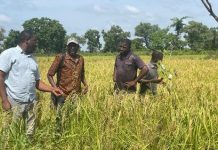By Ndey Sowe
An Interim project report 2019-2020 on “Improving Food Security and Nutrition in The Gambia through Food Fortification” has revealed that the country is classified as a low-income country, struggling with or affected by food deficiency.
The Gambia is located on the West African Coast and has a population of 2.3 million people (Gambia Labour Force Survey 2018). Seventy-one percent (71%) of the population live below the poverty line of 1 US dollar per day and the Gambia’s Human Development Index (HDI) value for 2019 is 0.466. This, places the country in the low human development category positioning it at 174 out of 189 countries and territories.
The 2013 national Demographic Household Survey (DHS) found that one out of four children under five were stunted and 11.5% wasted. Two out of three children under five, one out of three pregnant women and 16% of lactating mothers had Vitamin A deficiency. About 75% of all women had iron deficiency; and two thirds of pregnant women and about 50% of lactating mothers were anaemic.
This revelation came on Wednesday, 26th May, 2021, during the 8th National Alliance for Food Fortification (NAFF) meeting with relevant stakeholders to discuss the importance and way forward on food fortification held at a local hotel, Senegambia.
“Nutritional deficiency occurs when the body doesn’t absorb or get from food the necessary amount of nutrient. Deficiencies can lead to a variety of health problems. These can include digestion problems, skin disorders, stunted or defective bone growth, and even dementia,” according to World Health Organization (WHO).
In 2016, FAO Gambia responded to the call for proposals for Inclusive and Sustainable Value Chains and Food Fortification, specifically Lot 2 on Food Fortification and won one of the grants from the European Union worth about 4,484,304 Euros.
The proposed action of the “Improving Food Security and Nutrition in the Gambia through Food Fortification” project was to support government capacity through provision of technical support for food fortification and associated legislation development, institutional, strengthening awareness raising as well as capacity building at community level.
Overall, the project contributes to the improved nutritional and health status of vulnerable populations suffering from micronutrient deficiencies throughout The Gambia, particularly women, girls and children, whose consumption of micronutrient fortified foods, will increase.
In an interview, Solange Heise, Project Coordinator Food Fortification from the Food and Agricultural Organisation (FAO), said the project aims to introduce fortified food and also encourage Gambians to eat more micronutrient food.
“The nutrition status of the Gambians is very poor. This includes stunting, wasting, underweight, and micronutrient deficiencies like aneamia, iron deficiency, Vitamin A Deficiency,” she remarked.
In addressing the micronutrient deficiency, Madam Heise said the National Nutrition Agency (NaNA) is the coordinating agency for nutrition program in the country so it was a good entry point for the project.
“Fortification to be strong and sustainable needs a public private partnership. We need to bring together all the relevant stakeholders for food fortification,” she said.
In doing so, she said the National Alliance for Food Fortification (NAFF) was established in 2018 under the lead and coordination of NaNA. The project will elapse in September, 2021.
With regard to sustainability, she said government should ensure owning the project, especially the regulation institutions such as the Food Safety and Quality Authority (FSQA), Ministry of Agriculture, NaNA as well as stakeholders in the private sectors, processors among others.
Madam Heise said at the end of the project, she will urge the EU and FAO to have NAFF biofortified crops available that can sustain all Gambians.
“We will like to see 80% of the Gambian population consuming fortified product namely, milled flour, salt and rice and to ensure the food Gambians are having is safe and nutritious,” she said.
Modou Cheyassin Phall, NaNA Executive Direction, expressed delight over what he called a very important structure.
“Malnutrition is still a major public health problem in The Gambia adversely affecting vulnerable groups among the population, especially women of reproductive age and children under five years,” he said.
This, he added, present a compelling case for continuous efforts to address all form of malnutrition in the Gambia.
Regarding micronutrient deficiency, The Gambia National Micronutrient Survey 2018 (GNMS 2018) puts the overall prevalence of Iron Deficiency (ID) and Iron Anaemia (IDA) at 59.0% and 38.2% respectively in Gambian children 6-59 months of age.
It indicated that the main reasons for the high prevalence of ID are low intake of iron and/or low bioavailability of iron in the diet. Nutritional aneamia is the main cause of aneamia in both children under five years and women, it stated.
“Both ID and IDA are strongly associated with Vitamin A Deficiency (VAD). VAD affects 18.2% of children in The Gambia, representing a moderate public health problem according to WHO criteria. At national level, VAD is low for women but it is still a problem for women in other areas of country. Only 10.8% of households assessed are using iodised salt,” the survey indicated.
Three years after the project launch, the malnutrition trends are decreasing every year. According to a comparison of the data from Gambia Demographic and Health Survey (GDHS) 2013 and 2019, stunting levels have decreased from 25% to 15%, underweight from 16% to 12% and wasting prevalence from 12% to 5% for children under five years.
According to WHO, food fortification or enrichment is the process of adding micronutrient (essential trace elements and vitamins) to food.





















